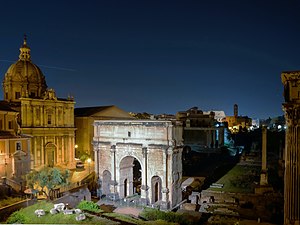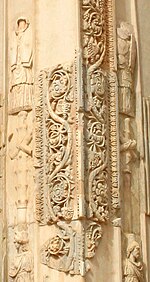Severan art
You can helpexpand this article with text translated fromthe corresponding articlein Italian.(December 2008)Click [show] for important translation instructions.
|
This article includes a list of generalreferences,butit lacks sufficient correspondinginline citations.(March 2020) |

Severan artis art production by theRoman Empireunder theSeveran dynasty,usually taken as running from 193 to 235, through the emperorsSeptimius Severus,Caracalla,HeliogabalusandAlexander Severus.Official Roman art of the military anarchy which followed, ending in 253 withGallienus,has no character of its own and so can be seen as a continuation of Severan art, and so that art can be seen as running for the whole first half of the 3rd century.[citation needed]
In this period began the process that ended in the rupture between Roman art and that ofLate Antiquity,the watershed between classical art and that ofByzantiumandthe Middle Ages.[citation needed]Some of Severan art's products saw the emergence of obvious elements fromplebeian artandprovincial art,whilst in other areas traditionallyHellenisticelements were kept alive longer, such as in portraiture, which flourished in this period with masterpieces of great psychological depth.[citation needed]
Historical context
[edit]This section is empty.You can help byadding to it.(July 2010) |
Sculpture
[edit]

The most important works in Severan art were theArch of Septimus Severusin the Roman Forum (erected for the Parthian triumph of 203); the Forum, the basilica and theArch of Leptis Magna,the birthplace of the emperor (completed by 216); and theArcus Argentariorumin Rome, erected in honor of the emperor by the bankers of theForum Boariumin 204.
Leptis Magna
[edit]This section is empty.You can help byadding to it.(January 2011) |
Rome
[edit]This section is empty.You can help byadding to it.(January 2011) |
Portraits
[edit]TheRoman portraitin the third century was one of the most significant art forms of the period. The artists, now free from the constraints linked to the Hellenistic tradition, implemented expressive characteristics intophysiognomicportraits in marble and bronze.[citation needed]From this new style of portrait one could infer the socio-economic situation, and the difficulties of life faced by farmers soldiers.[citation needed]
The imperial portraits are fundamental, from which the main artistic currents of the time can be outlined. The chronology of the most important works is:
- Portrait of Caracalla,211-217
- Portrait of Severus Alexander,222-235
- Portrait of Maximinus Thrax,235-238
- Portrait of Gordian III,238-244
- Portrait of Philip the Arab,244-249
- Portrait of Decius,251
- Portrait of Treboniano Gallo,251-254
Also important are some portraits of empresses, including that of the influentialJulia Domna,wife of Septimius Severus and patron of Syrian artists in Rome, and that ofSallustia Orbiana,wife ofSeverus Alexander.
Typical of the time is the "engraving" process, with small superficial chisel strokes that draw the short hair and the hair of the beard, which was neither fashionable nor shaved, but kept short with scissors. These technical devices were frequent in Rome, though less often seen in the eastern provinces.[citation needed]
Sarcophagi
[edit]
Monumental sarcophagi are also very representative of the artistic methods in use during the period. In Rome, there are various specimens imported from Asia Minor, while works of Roman manufacture were exported to the western provinces. One of the best known works of this period is theLudovisi Battle sarcophagus,where the figure of the young commander on horseback was recognized asHostilian.[citation needed]Typical is the production of sarcophagi with lion hunting scenes, datable between 220 and 270, added to the recent stoic concept of life as a militia.[citation needed]Other types are instead linked to theCult of Dionysusadorned with symbolism that alludes to regeneration after death, just crushed grapes or wine.[citation needed]
Indicative of the moral thinking of individuals of the time are sarcophagi where the deceased are depicted as philosophers or muses. From these representations, born in a context strongly anchored to paganism, evolved the typologies ofcrypto-Christiansarcophagi of the end of the third century.[citation needed]Figures representing Christ and the apostles were depicted.
Reliefs
[edit]This section is empty.You can help byadding to it.(July 2010) |

Architecture
[edit]In Rome, in the wake of the fire of 191, Septimius Severus instituted a new phase of construction: theTemple of Peace,theHorrea Piperiana,and thePorticus Octaviaewere rebuilt; a wing was added to the imperial palace on thePalatine Hill,with a new monumental facade towards theVia Appia;and theSeptizodium,the arch of Septimius Severus and theBaths of Caracallawere raised. It is likely that theTemple of Serapiswas rebuilt by the Severans.
Painting
[edit]There are few remaining paintings from the period, and dates can only hypothesized. The best studied examples are theFayum mummy portraits,dated from the late 1st century BC or the early 1st century AD onwards. It is not clear when their production ended, but recent research suggests the middle of the 3rd century.
Notes
[edit]Bibliography
[edit]- (in Italian)Ranuccio Bianchi Bandinelli& Mario Torelli,L'arte dell'antichità classica, Etruria-Roma,Utet, Torino 1976.
- (in Italian)Pierluigi De Vecchi & Elda Cerchiari,I tempi dell'arte,volume 1, Bompiani, Milano 1999







